Overview
By 2025, the commercial real estate office market will be significantly shaped by several key trends:
- The rise of hybrid work models
- A growing demand for flexible office spaces
- An increased focus on sustainability and technology integration
These trends are not merely passing fancies; they are driven by evolving workforce demographics, economic pressures, and the pressing need for adaptable environments that enhance employee well-being and productivity. This indicates a profound transformation in the design and utilization of office spaces, compelling stakeholders to rethink their strategies.
As we navigate this changing landscape, it is essential to recognize the implications for investment decisions. The shift towards hybrid work models suggests that traditional office layouts may no longer suffice, prompting a reevaluation of space requirements. The demand for flexible office solutions speaks to a broader trend of customization and adaptability, which is becoming increasingly vital in attracting and retaining top talent. Furthermore, the emphasis on sustainability and technology integration highlights the necessity for forward-thinking investments that align with contemporary values and operational efficiencies.
In conclusion, these trends present both challenges and opportunities for investors and developers alike. Understanding these dynamics will be crucial for making informed decisions that not only respond to current market demands but also anticipate future shifts. By leveraging these insights, stakeholders can position themselves advantageously in a rapidly evolving market.
Introduction
In the ever-evolving landscape of commercial office spaces, a convergence of trends is reshaping how businesses approach their environments. As hybrid work models gain traction, the demand for flexible and adaptable office solutions has surged. This prompts organizations to rethink their spatial needs, not solely to accommodate workforce preferences but also to integrate cutting-edge technology and sustainable practices that enhance employee well-being and productivity.
Economic factors, changing tenant demographics, and regulatory challenges add layers of complexity that stakeholders in the commercial real estate market must navigate. The future of office spaces transcends mere physical locations; it is about creating environments that foster collaboration, innovation, and a sense of community in an increasingly digital world.
Key Trends Influencing the Future of Commercial Office Spaces
The commercial real estate office market is currently experiencing significant transformations, driven by several pivotal trends. A primary factor is the widespread adoption of hybrid work models, fundamentally altering how companies approach their facility requirements. This shift has resulted in a substantial rise in demand for flexible office spaces, enabling organizations to adapt to diverse workforce needs and preferences.
As businesses increasingly prioritize work-life balance, the necessity for adaptable environments catering to varied employee needs has become critical. Yet, the integration of technology into workplace design also presents challenges. Notably, 34 percent of employees report a decline in collaboration due to AI implementation within their organizations. Despite these hurdles, companies are progressively harnessing advanced technologies to foster efficient, collaborative, and engaging workspaces.
This trend not only boosts employee productivity but also aligns with the evolving expectations of a modern workforce. For example, the case study titled "Impact of AI on Facilities Management" illustrates how AI is revolutionizing facilities management, offering insights into post-crime considerations for FM teams and enhancing overall business prosperity.
As organizations reevaluate their spatial needs, grasping these trends in the commercial real estate office market is essential for investors and property managers alike. The capability to anticipate shifts in demand and adjust to the changing landscape will be vital for navigating the complexities of this sector. Jerome Powell's recent statement that "rate cuts will be put on hold until concerns about inflation improve or an unexpected decline in employment occurs" highlights the broader economic context that may influence real estate investment decisions.
With cities like Austin and Miami leading the surge in sale prices at $396 and $365 per square foot, respectively, it is evident that the industry is dynamically responding to these emerging trends. Therefore, it is crucial for stakeholders to remain informed and adaptable.

Economic Factors Driving Change in Office Real Estate
Economic conditions serve as a critical determinant in the commercial workspace market landscape. As interest rates rise, companies face increased borrowing costs, prompting a reassessment of their premises needs. This trend is particularly evident in 2025, as many organizations reevaluate their strategies in the commercial real estate office market amid financial pressures.
Inflation further exacerbates these challenges, inflating operational expenses and influencing decisions regarding workplace utilization.
Additionally, fluctuations in employment rates significantly impact demand for workspace. Companies may opt to downsize or expand their physical footprint based on workforce dynamics, which can vary widely across different regions. A recent survey of real estate companies managing assets of at least US$75 million revealed that North America and Asia Pacific exhibit greater optimism regarding leasing conditions compared to Europe, where respondents expressed more caution, particularly concerning leasing and lending conditions.
This sentiment is illustrated in the case study titled "Regional Sentiment in Commercial Real Estate," which highlights these varying levels of optimism across regions.
For instance, New York has experienced a notable recovery in attendance at workspaces, achieving 82% utilization as of October 2024, with top-tier buildings reaching an impressive 91% utilization rate. Richard Wobbekind, Ph.D., notes that this shift signifies a growing preference for high-quality properties in the commercial real estate office market, reflecting broader economic trends and changing workplace dynamics. His insights underscore the importance of understanding these economic factors for making informed investment decisions in the commercial real estate office market.
Zero Flux's commitment to quality content enhances subscriber engagement, ensuring that investors are equipped with reliable insights as the market continues to evolve. Staying attuned to these dynamics empowers investors to navigate the complexities of commercial property effectively.
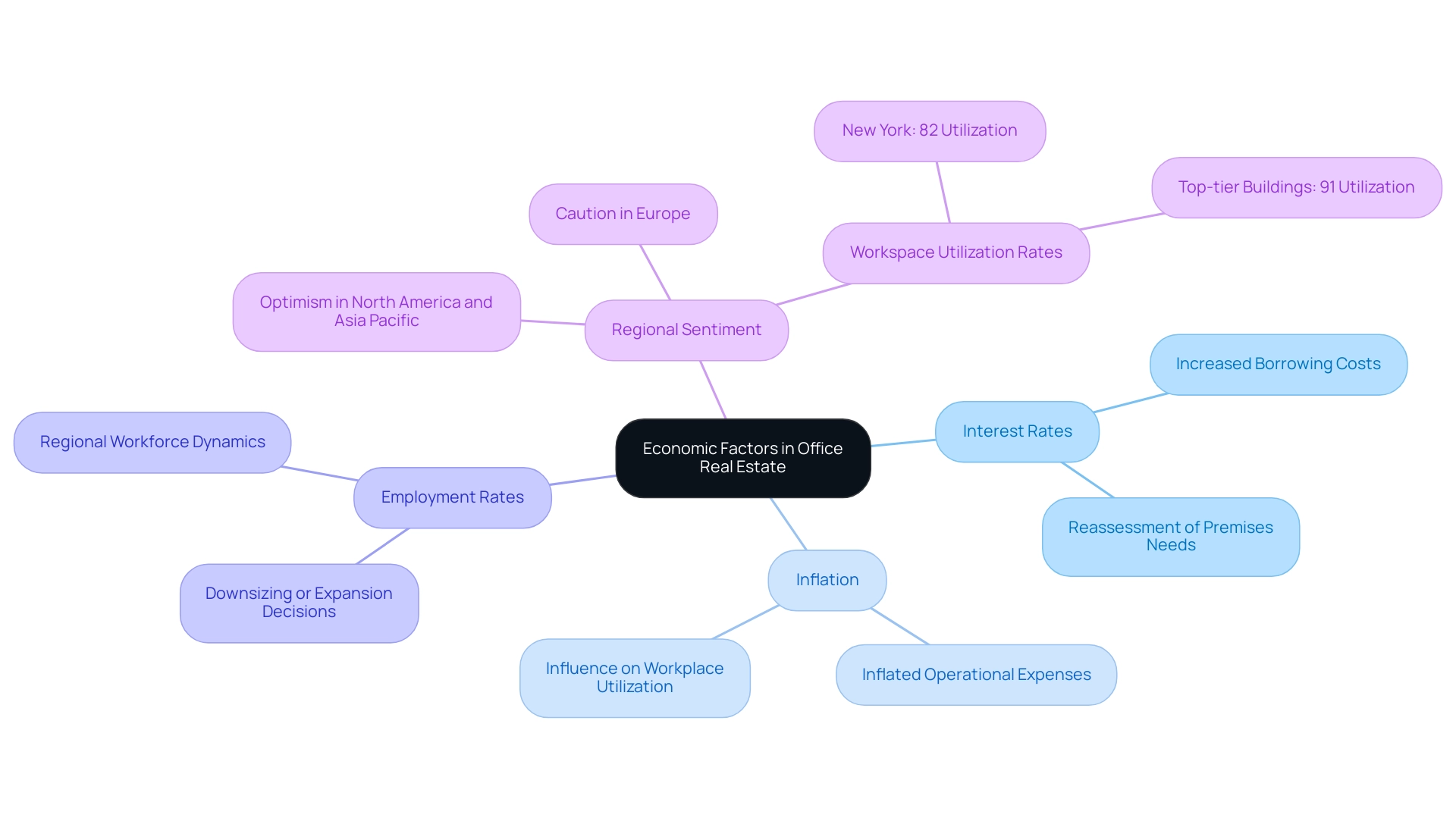
Changing Tenant Demographics and Their Impact on Office Space Needs
The landscape of the commercial real estate office market is undergoing a significant transformation as workforce demographics shift. With younger generations increasingly joining the labor market and older generations retiring, there is a rising need for workplaces that provide features designed for a diverse workforce. By 2025, this trend is anticipated to manifest as wellness environments, collaborative areas, and advanced technology integration, all aimed at improving employee satisfaction and productivity.
As companies strive to attract and retain top talent, the importance of creating appealing work environments cannot be overstated. Research indicates that nearly 70% of employees prioritize workplace amenities when considering job offers, underscoring the need for property owners to adapt their offerings accordingly. This shift is not merely a trend but a necessity, as organizations recognize that a well-designed workspace can significantly impact employee morale and retention rates.
Moreover, the integration of smart technologies and IoT solutions is becoming increasingly vital. Collaborations with innovative firms such as Appinventiv can aid in the creation of contemporary work environments that meet the requirements of a varied workforce. For instance, amenities such as fitness centers, relaxation zones, and flexible workspaces are now viewed as essential elements of workspace design.
Additionally, data centers could experience a 10% annual rent growth due to supply-demand imbalances, highlighting the dynamic nature of the market.
In light of these changes, property owners must stay attuned to the evolving preferences of tenants. The impact of younger generations on workplace amenities is profound, as they often seek environments that foster collaboration and well-being. As Anthony A. Luna observes, 'Investors are discovering opportunities in office environments that can adjust to hybrid work models,' further emphasizing the necessity for flexibility in office design.
Furthermore, the case study on New Zealand's property valuation process demonstrates the significance of transparency and trust in the changing commercial realty landscape. Consequently, the commercial real estate office market is positioned for substantial change, focusing on developing environments that not only fulfill functional requirements but also enhance the overall employee experience.
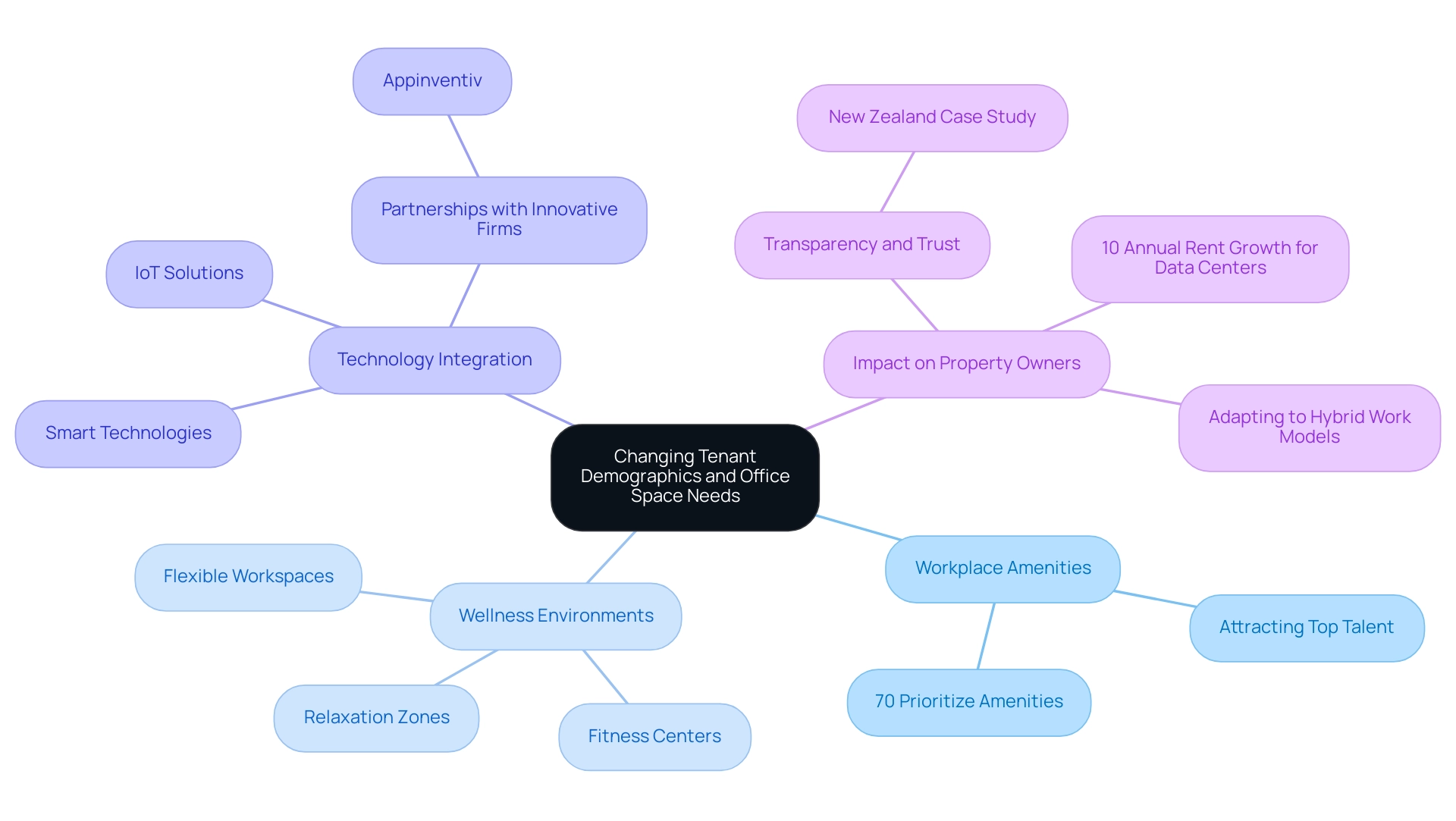
The Rise of Experiential Consumerism in Office Design
Experiential consumerism is reshaping workspace design as organizations increasingly prioritize the creation of engaging and adaptable environments. This trend highlights the necessity of spaces that foster collaboration, creativity, and overall well-being. Features such as open layouts, proven to enhance employee productivity, are becoming standard as companies recognize the profound influence of physical spaces on morale and performance.
Studies indicate that open workspace designs can lead to a 15% increase in productivity, making them a strategic choice for attracting and retaining top talent. Moreover, the integration of biophilic design—incorporating natural elements into the workspace—has gained traction, with many organizations investing in wellness amenities that support employee health and satisfaction. This approach not only enhances the aesthetic appeal of work environments but also contributes to improved mental well-being, fostering a more engaged workforce. Julie Hattersley, a designer, emphasizes this by stating, "Taking pride in her involvement through every step of the design process, Julie is inspired by her clients and relishes dissecting a brief to get to the essence of what will provide the end users with the best experience and improve their working days."
As the demand for collaborative workspaces continues to rise, companies are rethinking their office layouts to include areas that facilitate teamwork and innovation. The trend towards sustainability is also influencing design choices, with a growing emphasis on energy-efficient systems and eco-friendly materials. This shift aligns with the US Department of Energy's definition of zero-emission buildings, prompting organizations to adopt practices that reduce energy consumption and emissions.
The growing emphasis on sustainability is additionally backed by the fact that Zero Flux has over 30,000 subscribers, emphasizing its role as a dependable source for insights. Furthermore, the incorporation of AI and data analytics into the design process, as demonstrated in the case study titled "Embracing AI Tools for 'Science-Led Design,'" is poised to transform how environments are conceived and constructed. By leveraging predictive tools and research, designers can create environments that are not only efficient but also enhance the well-being of occupants.
In summary, the emphasis on experiential consumerism in workplace design is not simply a trend but a strategic necessity for organizations striving to succeed in the commercial real estate office market. By developing environments that prioritize collaboration, well-being, and sustainability, companies can enhance employee satisfaction and drive productivity, ultimately positioning themselves for success in the commercial real estate office market.
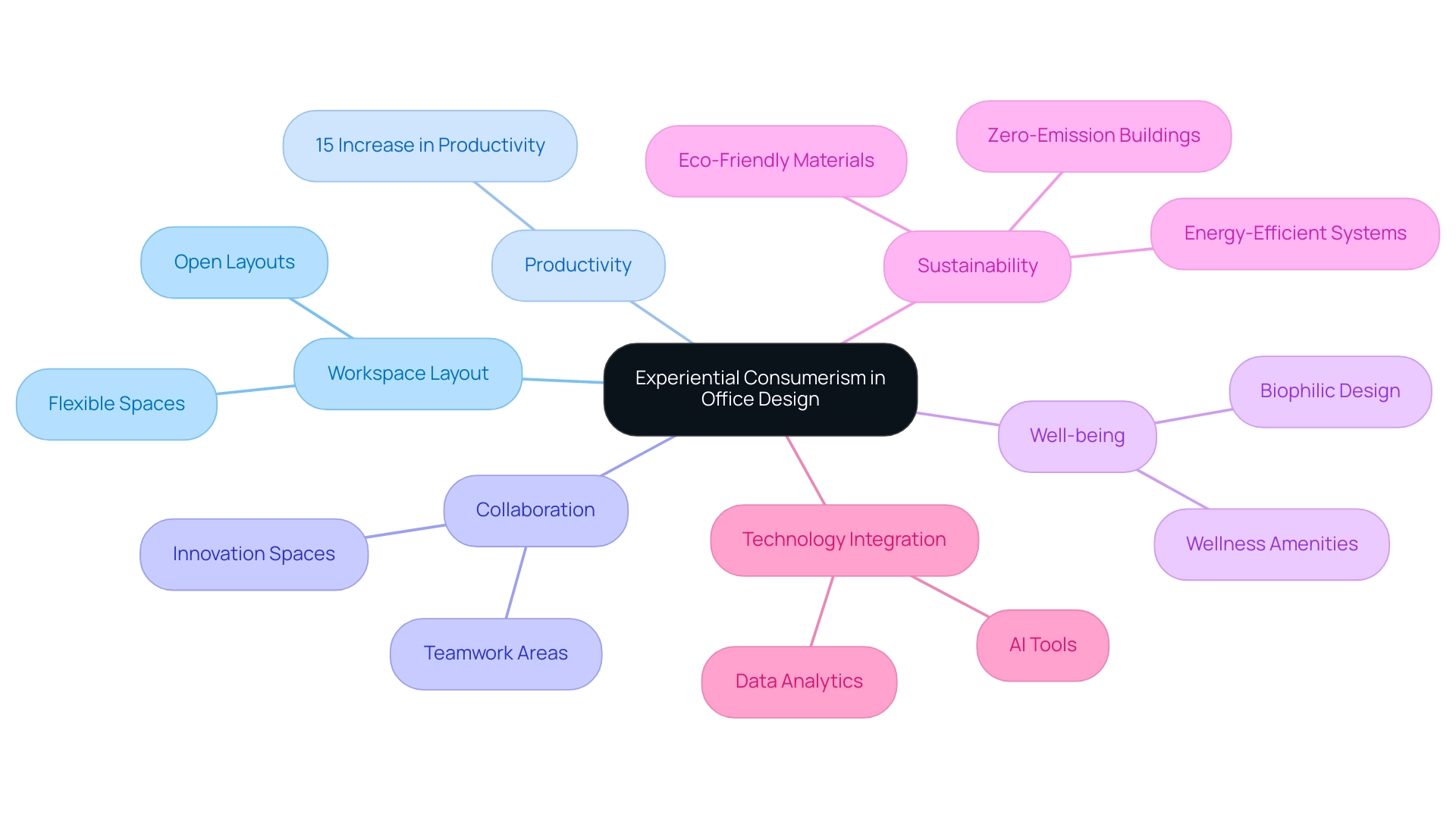
The Role of ESG Considerations in Office Market Trends
Environmental, Social, and Governance (ESG) considerations are becoming pivotal in shaping the commercial property market as stakeholders increasingly prioritize sustainability and social responsibility. Investors are actively seeking properties that adhere to rigorous environmental standards, while tenants demand locations that resonate with their values. This shift is driving the advancement of green structures and energy-efficient designs, which not only reduce operational costs but also enhance the appeal of properties in a competitive market.
By 2025, the demand for sustainable workspaces is expected to surge, with global ESG assets projected to exceed USD 40 trillion by 2030. This trend is fueled by a growing interest from both tenants and investors in low-carbon environments. Furthermore, the implementation of IFRS Sustainability Disclosure Standards, impacting non-EU headquartered companies starting in 2026, underscores the urgency for compliance and transparency in sustainability practices.
Case studies reveal that organizations are increasingly focusing on energy efficiency upgrades and social impact initiatives, balancing financial pressures with sustainability goals. For instance, addressing the workforce gap in the property sector has led companies to align with the values of younger generations, implementing upskilling initiatives to prepare for future workforce needs. This alignment not only fosters a more engaged workforce but also enhances the overall sustainability of operations. Notably, there is an estimated annual investment shortfall of €177 billion, totaling €1.77 trillion by 2030, with 74% of this gap tied to energy efficiency in buildings, highlighting the financial implications of these sustainability efforts.
As the commercial real estate office market evolves, understanding ESG factors is essential for investors aiming to meet market expectations and attract environmentally conscious tenants. The integration of sustainability into investment strategies is no longer optional; it is a critical component for success in the modern real estate landscape. Retailers are focusing on energy efficiency upgrades and social impact while balancing financial pressures with sustainability goals, further emphasizing the importance of these trends.
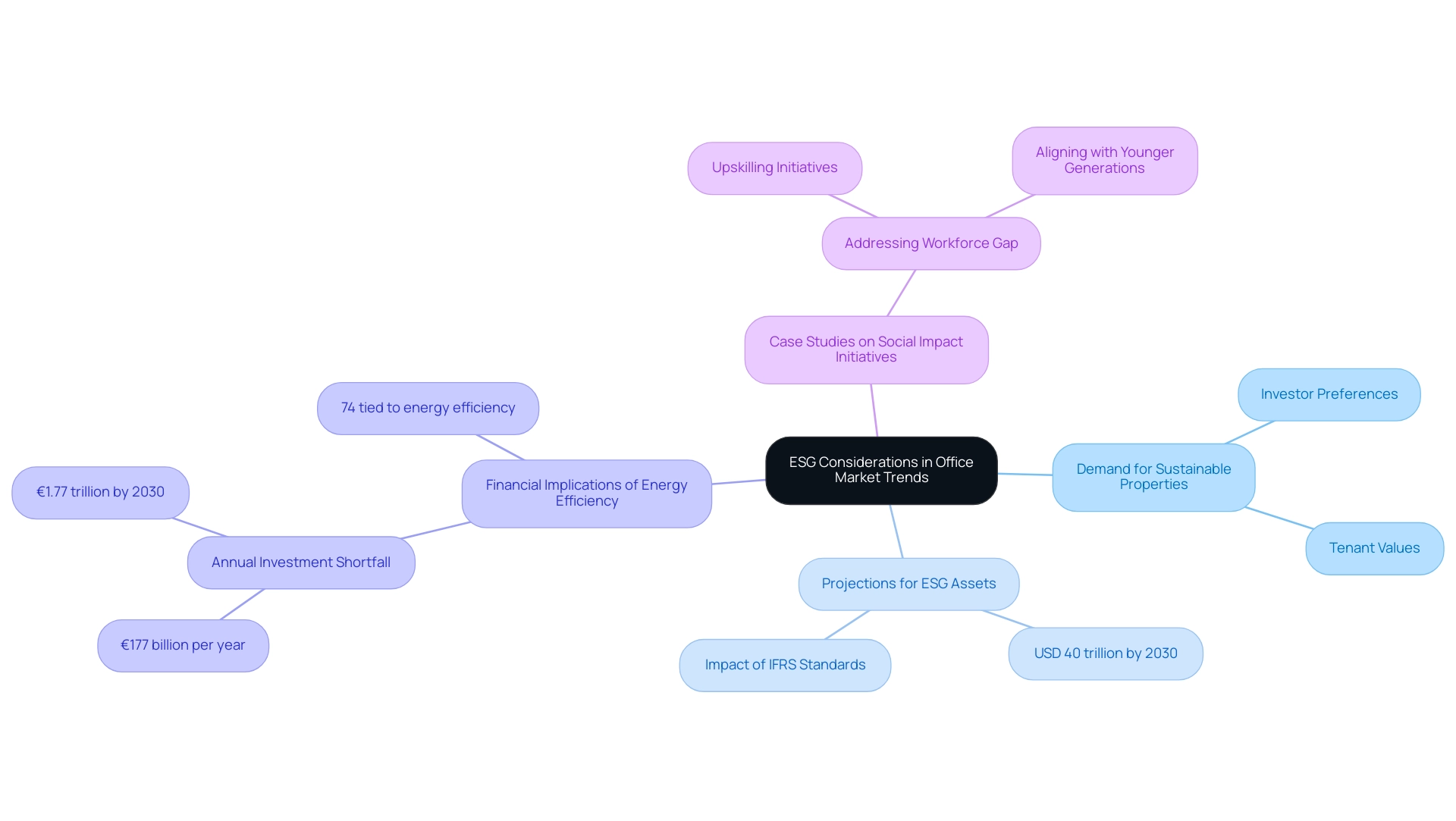
Digital Economy Growth and Its Influence on Office Space Design
The digital economy is fundamentally transforming workspace design, as companies increasingly rely on technology to optimize operations. This evolution necessitates the incorporation of smart technologies, including IoT devices and sophisticated communication systems, into contemporary work environments. As remote and hybrid work models gain traction, flexible workspaces have become essential.
Businesses are not only maximizing their real estate investments but also boosting employee productivity through intentional design. For instance, the AI company Harvey exemplifies this trend by doubling its footprint in New York City shortly after establishing a presence, clearly showcasing the growing demand for flexible work environments that can respond to changing business needs.
In reaction to persistent economic instability, numerous investors are broadening their portfolios, moving away from conventional commercial properties and investing in alternative sectors such as industrial real estate and multifamily housing. This strategic shift demonstrates a proactive approach to industry challenges, concentrating on optimizing cash flows and utilizing technology to enhance property management and tenant satisfaction.
Expert insights suggest that the future of workspace design will emphasize adaptability, sustainability, and technology-driven environments that improve employee well-being. Alysia Radicia, a partner and commercial sector co-leader at RDG Planning & Design, observes that the industry is experiencing a 'flight to quality,' with a demand for inspiring and distinctive environments that exemplify the best of adaptive reuse and innovative workplace design. Furthermore, the early integration of interior design, brand strategy, and experience design is projected to yield greater returns on investment, underscoring the importance of a holistic approach to workspace development in the digital age.
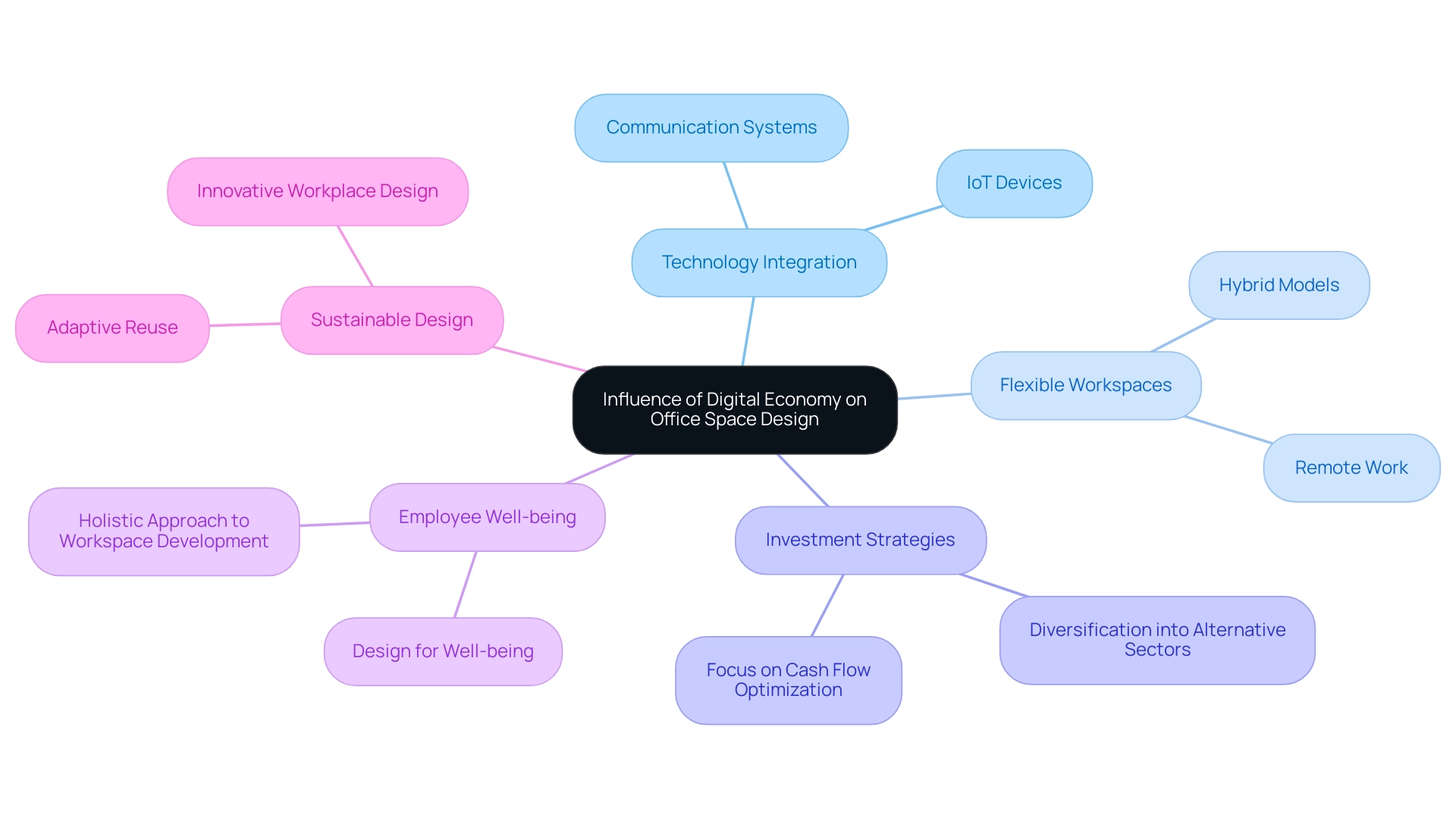
Navigating Tenant Acquisition Challenges in the Office Market
Tenant acquisition poses a significant challenge in the commercial space, particularly as vacancy rates continue to rise and competition intensifies. In 2025, property managers must implement innovative marketing strategies to effectively attract potential tenants. This includes offering flexible lease terms, modern amenities, and customized solutions that address the unique needs of businesses.
Recent trends indicate that the office sector is undergoing notable shifts, evidenced by a year-over-year decline in office employment of 0.1%, equating to a loss of approximately 35,000 jobs, predominantly within the Professional and Business Services and Information sectors. This decline underscores the urgency for property managers to reevaluate their tenant acquisition strategies in response to evolving industry dynamics.
To navigate these challenges successfully, a thorough understanding of the competitive landscape is essential. Property managers are increasingly leveraging data-driven insights to refine their marketing approaches. For instance, incorporating technology and digital marketing tools can significantly enhance visibility and engagement with prospective tenants.
Moreover, case studies reveal that properties featuring unique attributes, such as wellness-focused environments and sustainable practices, are more likely to attract tenants in today’s market. Expert opinions suggest that addressing tenant acquisition challenges necessitates a proactive stance. As Jerome Powell noted, economic uncertainties, including inflation concerns, are likely to persist, influencing tenant decisions. Therefore, property managers must remain flexible, continually adjusting their strategies to align with the needs of a changing workforce and economic conditions.
Furthermore, the growing emphasis on accelerated upskilling and reskilling initiatives highlights the evolving demands of tenants, which property managers should factor into their marketing strategies. Additionally, the acceptance of Building Performance Standards in several U.S. states and cities introduces another layer of regulatory consideration that property managers must navigate to attract tenants effectively. By prioritizing tenant needs and embracing innovative marketing tactics, property managers can enhance their occupancy rates and secure long-term success in the commercial sector. Notably, with 80% of Gen Z generative AI users believing that such technology will improve work/life balance, integrating modern amenities that cater to this expectation can further bolster tenant attraction efforts.
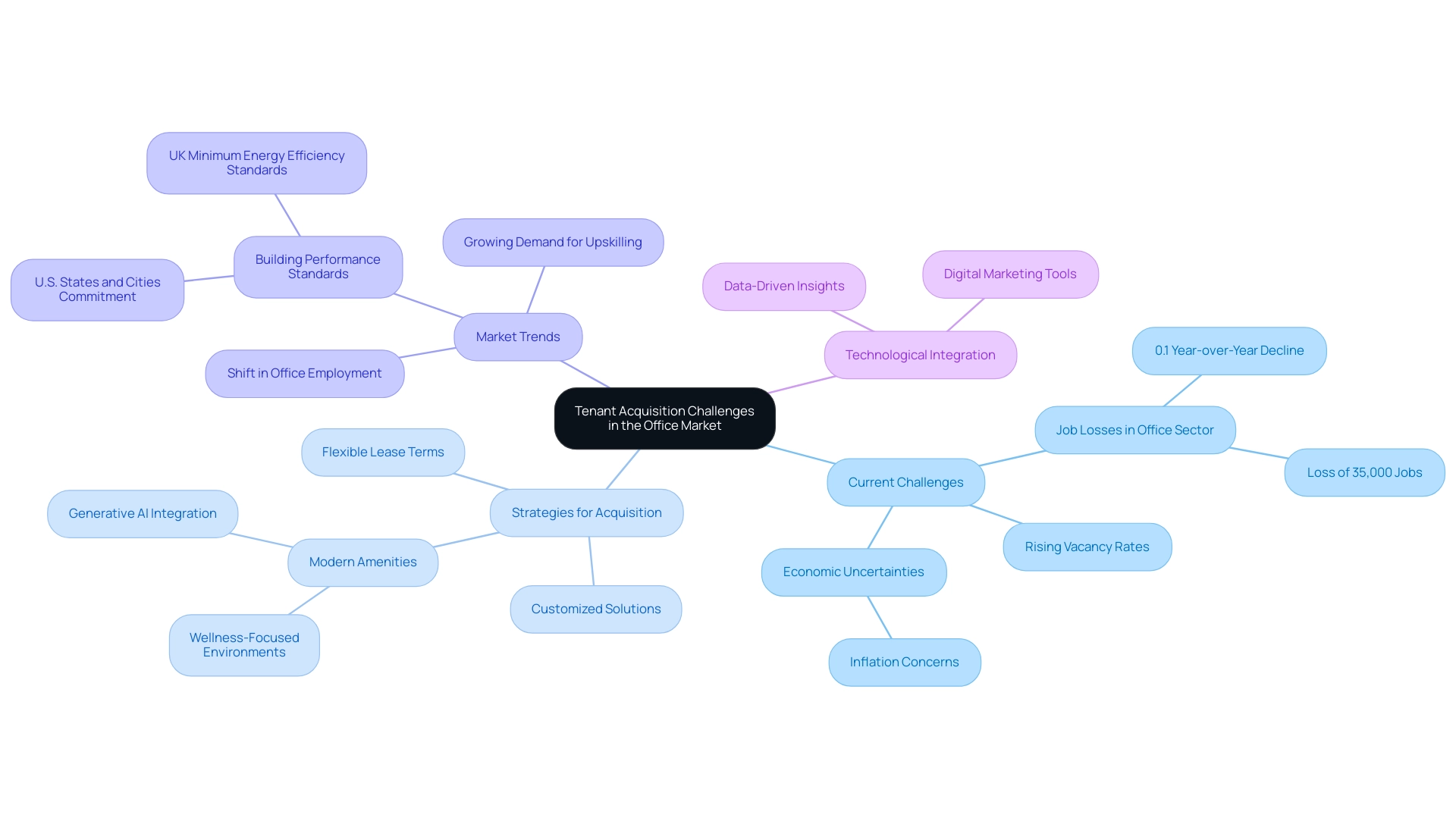
Workforce Housing Shortages and Their Impact on Office Market Dynamics
Workforce housing shortages are significantly influencing market dynamics, particularly in urban centers where the demand for housing consistently exceeds supply. This imbalance not only exacerbates the housing crisis but also leads to longer commuting times for employees, which can detrimentally impact their work-life balance and overall job satisfaction. Studies indicate that in 2025, employees facing extended commutes report lower satisfaction levels, hindering productivity and retention rates.
As companies strive to attract and retain top talent, the availability of housing options becomes a crucial factor in their location decisions. The Counselors of Real Property believes that declining multifamily construction and greater demand from younger renters will aggravate affordability challenges in 2025, complicating the landscape for real property investors. Investors and property managers must recognize that the proximity of affordable housing to office spaces can directly affect employee satisfaction and, consequently, the success of their investments.
For instance, a recent analysis revealed that businesses located near accessible housing options experience higher employee retention rates. This underscores the importance of integrating housing availability into property strategies.
Zero Flux, with over 30,000 subscribers, addresses the challenge of information overload in the realty sector by filtering vast amounts of data to highlight only the most relevant trends. Understanding these dynamics is essential for navigating the complexities of the commercial real estate office market. By prioritizing areas that provide both workspace and nearby residences, stakeholders can refine their strategies to address the changing requirements of the workforce and improve overall performance.
Efficient processes and partnerships with reliable suppliers are critical for builders to meet buyer expectations and ensure timely project completion. This further emphasizes the need for a strategic approach to housing availability.
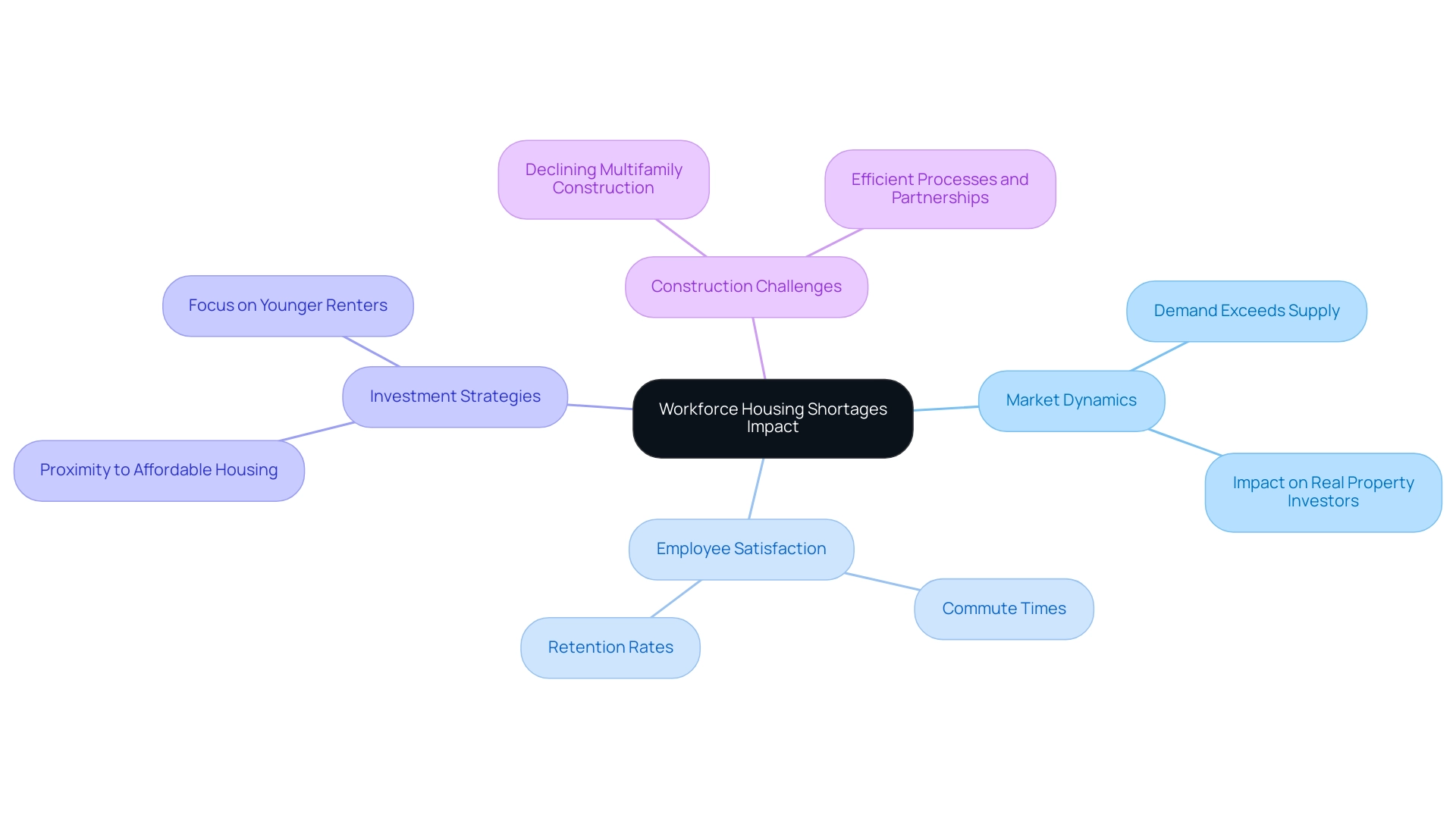
Regulatory and Legal Challenges Facing the Office Market
The commercial real estate office market is currently navigating a complex landscape of regulatory and legal challenges that significantly influence investment strategies and property management. Key among these are:
- Zoning laws
- Building codes
- Environmental regulations
All of which can directly impact development projects. For instance, a recent report highlights that the industrial sector is expected to undergo significant changes as it approaches 2025, with stabilizing vacancies and slowing construction activities redefining the market. This underscores the importance of understanding these regulatory frameworks.
Moreover, evolving labor laws and tenant rights are adding layers of complexity to leasing agreements and operational practices. The recent decline in employment in the Twin Cities, marked by a 4% drop translating to 19,000 jobs lost year-over-year, illustrates the pressing need for property owners and managers to adapt to these changes.
Expert insights emphasize that strong public-private relationships are crucial for development, particularly in affordable housing initiatives, which can also influence workspace dynamics. Tim Coy, the research manager for the Commercial Real Estate sector within Deloitte’s Center for Financial Services, asserts that these relationships are vital for effectively navigating the regulatory landscape.
As zoning laws change, their impact on commercial development, particularly in the commercial real estate office market, becomes increasingly pronounced, necessitating a proactive approach from investors and managers alike. Furthermore, the Federal Reserve's recent decision to reduce its benchmark interest rate by 50 basis points in September and an additional 25 basis points in November provides critical context concerning the economic landscape affecting the commercial real estate sector. Staying informed about these regulatory changes is essential for mitigating risks and ensuring compliance, ultimately shaping the future of investments in the commercial real estate office market.
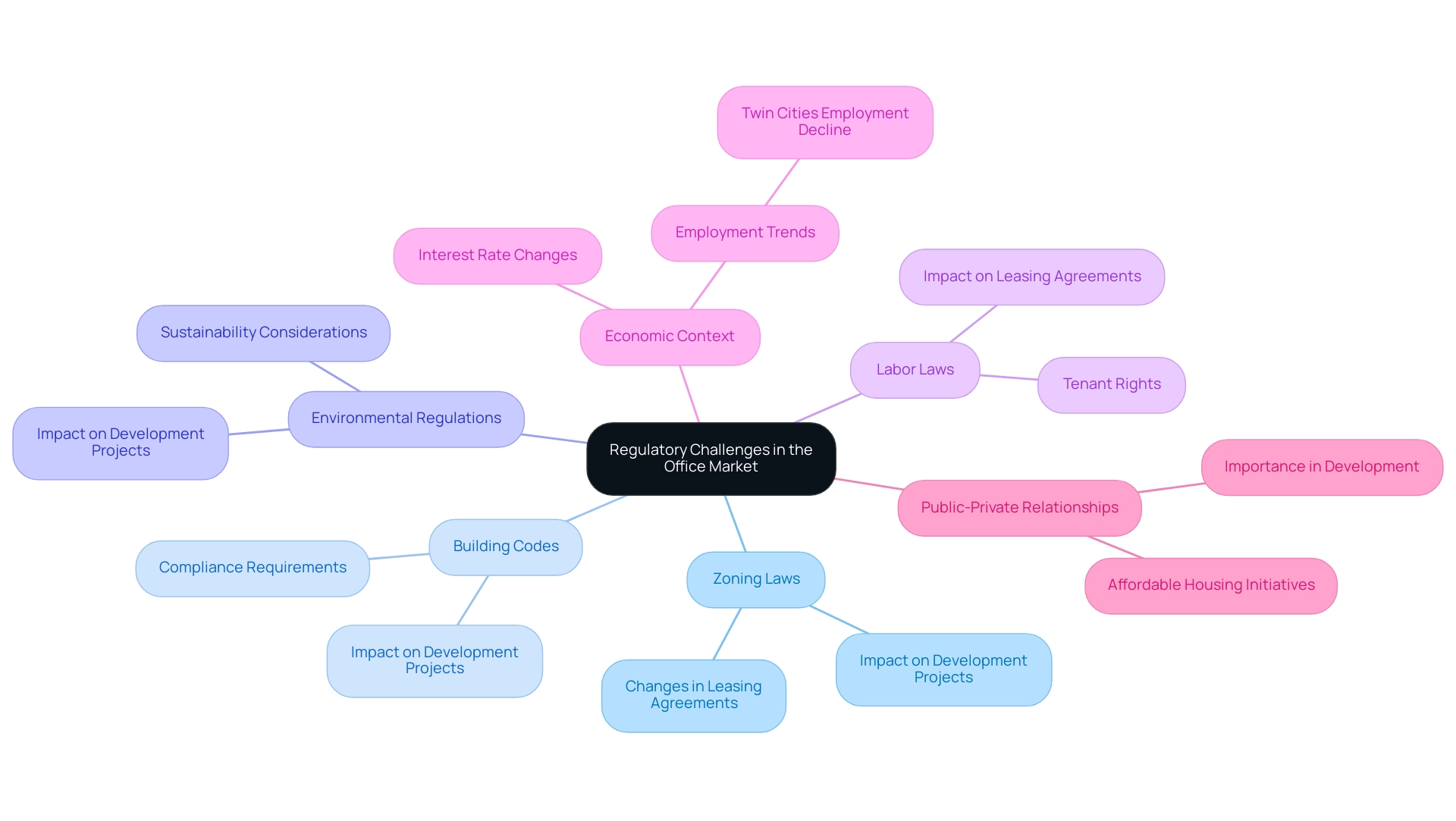
Future Outlook: What Lies Ahead for the Commercial Office Market by 2025
As we approach 2025, the commercial real estate office market is poised for significant transformation, driven by several key trends. The integration of advanced technology will play a pivotal role, with companies increasingly adopting smart building solutions to enhance operational efficiency and tenant experience. This shift is underscored by findings from Deloitte’s 2025 commercial real estate outlook survey, which indicates that a notable 68% of respondents anticipate financing will become less expensive, and 69% expect it to be easier to obtain.
This favorable financing environment is expected to facilitate investments in innovative technologies that enhance the functionality of workspaces.
Sustainability remains a critical focus, as organizations are urged to weave eco-friendly practices into their core strategies. This involves managing climate risks efficiently while addressing the increasing demand for sustainable work environments. The emphasis on green building certifications and energy-efficient designs is expected to resonate strongly with tenants, particularly as demographic shifts reveal a preference for workplaces that prioritize environmental responsibility. Realty companies that incorporate sustainability into their operations not only adhere to regulations but also draw a more aware tenant base.
Furthermore, the demand for adaptable workspaces is poised to increase, fueled by the ongoing adjustment to hybrid work models. Companies are increasingly acknowledging the significance of employee well-being, resulting in a rise in innovative workspace designs that encourage collaboration and comfort. This trend aligns with the shift towards skills-based organizations, where real estate firms are encouraged to adopt more agile structures to meet project needs and bridge skills gaps. Such a method not only improves problem-solving skills but also cultivates a more vibrant work atmosphere, enabling companies to react quickly to market shifts.
Forecasts for workplace demand by 2025 indicate an ongoing transformation, with industrial and manufacturing properties rising as the leading opportunity in North America. This trend suggests a change in investment emphasis, as these sectors are expected to stimulate demand for the commercial real estate office market facilities that support their operations. As real estate leaders identify accelerated upskilling and reskilling initiatives as essential strategies for attracting and retaining talent, these changes will undoubtedly be reflected in the commercial real estate office market.
Investors and property managers must remain vigilant and adaptable to seize emerging opportunities while effectively navigating the challenges posed by these evolving market dynamics.
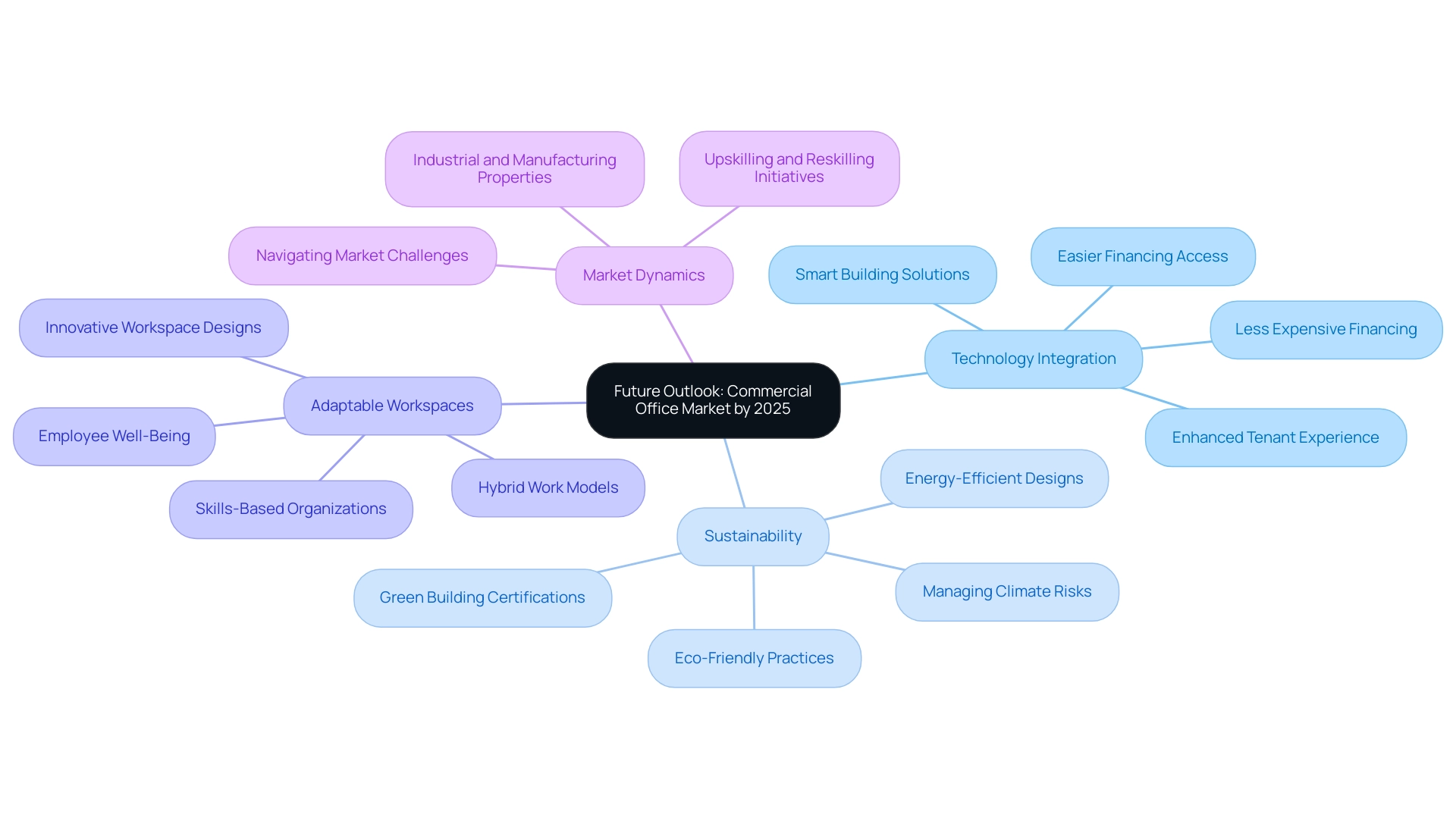
Conclusion
The commercial office market is experiencing a significant transformation, propelled by hybrid work models, economic pressures, and evolving tenant demographics. Organizations are increasingly pursuing flexible and adaptable workspaces, making technology integration and sustainable practices more critical than ever. Companies are not merely reassessing their spatial needs; they are also placing a premium on employee well-being and productivity. This shift highlights the necessity of creating environments that encourage collaboration and innovation—an essential component in today’s digital-first landscape.
Navigating the complexities of the commercial real estate landscape demands that stakeholders remain informed and agile. Economic factors, including rising interest rates and inflation, are reshaping investment strategies and tenant acquisition processes. As competition intensifies and vacancy rates climb, property managers must implement innovative marketing strategies that resonate with the shifting preferences of tenants, particularly younger generations who value amenities and sustainability.
Looking ahead to 2025, the demand for office spaces that embody flexibility, sustainability, and advanced technology is anticipated to surge. Investors and property managers must recognize that aligning their strategies with these trends will be crucial for success. By embracing adaptability and prioritizing the overall employee experience, stakeholders can position themselves to thrive in an ever-evolving market, ultimately shaping the future of commercial office spaces.

